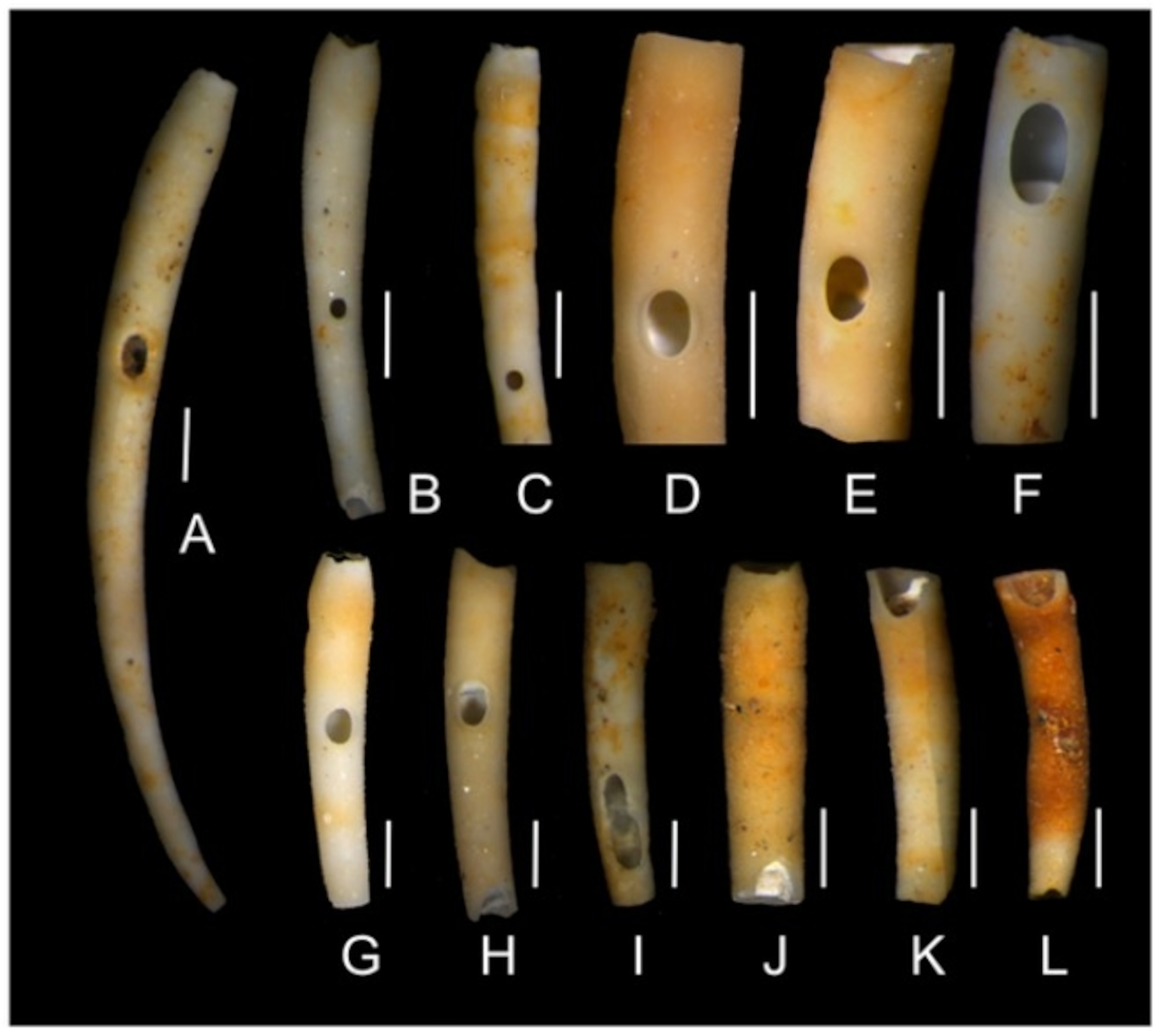This is a post about worm holes. Not the physics kind, but the kind an unknown predator bored into the tubes of fossil annelids.
For the most part, worms were not the best candidates for entry into the fossil record. Many were just too damn squishy. Such soft invertebrates had to be buried in circumstances of high-fidelity preservation to fossilize. Yet there are some important exceptions. Some worms surrounded themselves with more durable hard parts which stood a better chance of surviving in stone. The armored machaerid worms of the Paleozoic are one example, but paleontologists also know a bit about tube-dwelling worms thanks to the homes some prehistoric polychaetes left behind. And, as researchers Jordi Martinell, Michal Kowalewski, and Rosa Domènech found out when they surveyed the fossilized tubes of prehistoric serpulid worms, these fancy invertebrates often came under attack.
Serpulid worms are not just creatures of the past. They’re still around today. These little segmented worms build permanent, calcium-carbonate tubes on whatever suitable substrate is available — including the tubes of other worms — and they were doing much the same around 3 million years ago off the coast of Spain. Today, their fossils can be found in Pliocene marine deposits along the southern coast near Cabo Cope. That’s where Martinell and collaborators collected their specimens of Ditrupa arietina. This species is still around, and is typically cast as a filter feeder that thrives in disturbed environments.
Martinell, Kowalewski, and Domènech were not after the worms themselves so much as fossils-within-fossils — bore holes in the serpulid tubes. Bore holes have been found in other serpulid worms from different places and times, not to mention all the various other invertebrate taxa which suffered drilling predators. The arms race between hard-bodied invertebrates and drilling predators goes back over 540 million years, to about the time of the earliest animals themselves.
Despite this wealth of data, though, Martinell and co-authors point out that the relationship between victims and drillers is better studied in some groups than others. We know quite a bit about how mollusks were both predators and victims in the drilling arms race, and how some prehistoric echinoderms were bored into by parasites. But serpulid worms have not been as well-studied. That’s what led the paleontologists to collect several bulk samples of the worm tubes from several fossil horizons at Cabo Cope. By studying the specifics of the damage to the tubes, and the pattern of damage through the fossil section, they could track the how drilling predators attacked their sessile prey.
All of the samples contained worm tubes damaged by drilling. The bores varied from circular to oval in outline, and were found on only one tube wall in each case. None of the drilled worms shows signs of repairing the damage. Altogether, the scientists cataloged 233 drilled specimens from a sample of thousands — only 3.9 percent of the tubes in the sample showed signs of damage. But this number might be too low. Most of the tubes in the sample were fragmentary, and many appear to have broken across the holes drilled into them. The obviously drilled tubes were only those which remained intact after the damage had been inflicted. Many more worms were attacked, and their compromised tubes later broke.
Relatively small worms seem to have been especially vulnerable. The specimens with bore holes punched into them were smaller than intact, undrilled ones. Exactly what sort of creature was drilling into the worms, however, is unclear. The holes are attributable to a commonly seen form of damage given its own name — Oichnus paraboloides — but multiple kinds of predators can create boreholes of this type, from snails and cephalopods to nematode worms. And, as far as Martinell and colleagues found, none of the usual drilling suspects has been found at Cabo Cope.
But, regardless of identity, the predator seems to have been an efficient driller. Only a handful of worm tubes show multiple holes — clues to failed attempts before the predator got the worm. Most of the holes were toward the anterior part of the tube, as well, indicating that the predator was targeting a specific area and was not just drilling anywhere. And the attacker seems to have preferred smaller worms. The hunter went after a specific size class of worm in a consistent way.
Unless a special fossil records the predator in action, we might not ever know what was going after these tube worms. But these small and abundant fossils are ancient records of interactions that are still going on today — the same species of tube worm is still attacked by drilling predators. I often write about the past and just how different things used to be, but, in cases like this, we can look at the modern world and see relationships that have been in place for millions of years.
References:
Martinell, J., Kowalewski, M., & Domènech, R. (2012). Drilling Predation on Serpulid Polychaetes (Ditrupa arietina) from the Pliocene of the Cope Basin, Murcia Region, Southeastern Spain PLoS ONE, 7 (4) DOI: 10.1371/journal.pone.0034576

